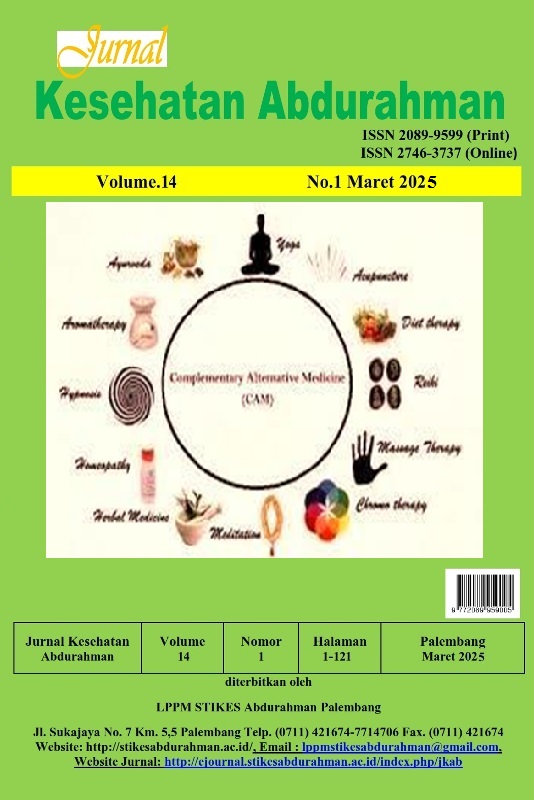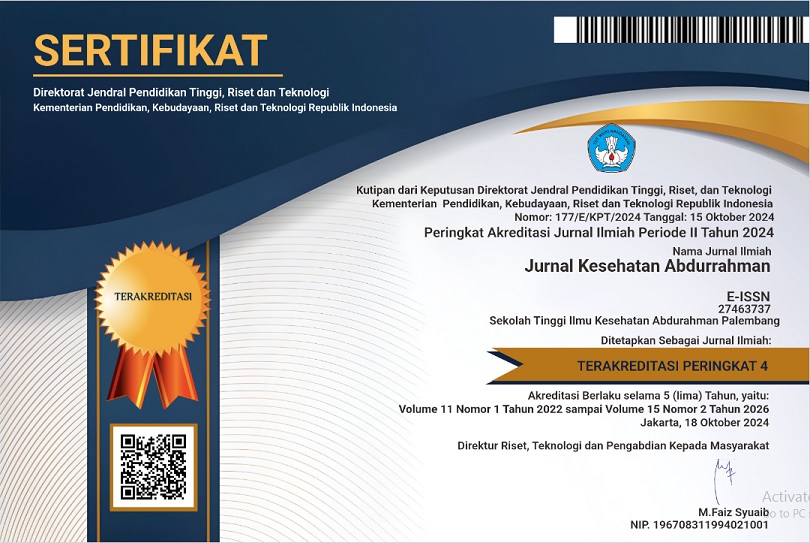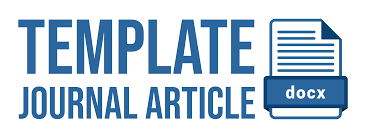HUBUNGAN ANTARA KADAR HEMOGLOBIN DAN STATUS GIZI DENGAN GANGGUAN SIKLUS MENSTRUASI PADA SISWI
Abstract
Background: Menstrual disorders often occur in adolescents, in the world the prevalence of menstrual cycle disorders in early adolescent women is around 45%, menstrual disorders can be serious. can be a sign of no ovulation, heavy bleeding and occurs over a long period of time can cause anemia in adolescents factors related to menstrual cycle disorders include stress, nutritional status, hemoglobin levels, physical activity, and sleep duration.
Purpose: This study aims to determine the relationship between hemoglobin levels and nutritional status with menstrual cycle disorders in SMK students.
Methodology: This study is a quantitative research that is correlational, the method used is non-experimental with cross sectional. The sample in this study amounted to 70 respondents, female adolescent students in grades X-XII. The sampling technique used purposive sampling technique, using the Chi square test.
Research Results: Univariate results showed that the majority of respondents did not experience menstrual cycle disorders 57.1%, the majority of normal hemoglobin levels 70% and the majority of normal nutritional status (58,6%. Bivariate results show a relationship between hemoglobin levels (p-value = 0.018) and nutritional status (p-value = 0.004) with menstrual cycle disorders.
Conclusion: there is a relationship between hemoglobin levels and nutritional status with menstrual cycle disorders in female students of SMK.
Suggestion: Young women need to consume iron supplements regularly and their nutritional status should remain in the normal category, namely by maintaining a healthy diet, exercising regularly so that their nutritional status is normal and their hemoglobin levels are normal and not anemic.
References
Anamisa, D. R., (2018), Rancang Bangun Metode OTSU Untuk Deteksi Hemoglobin, Journal of Chemical Information and Modeling, 5(2), 207–211.
Dya, N.M. dan Adiningsih, S., (2019), Hubungan antara Status Gizi dengan Siklus Menstruasi pada Siswi MAN 1 Lamongan. Jurnal Amerta Nutrition, 6(12), 8–16.
Evelyn C.P., (2019), Anatomi dan Fisiologi untuk paramedis, Gramedia, Jakarta, 62-64.
Kemenkes, (2019), Tabel Batas Ambang Indeks Massa Tubuh (IMT). P2PTM, Kementerian Kesehatan RI, Jakarta.
Kusmiran, E., (2018), Kesehatan Reproduksi, Salemba Medika, Jakarta, 52-67.
Murray, S., McKinney, E., Holub, K. S., dan Jones, R., (2019). Foundation of Maternal-Newborn and Women’s Health Nursing (7th ed.). ELSEIVER.
Nasrawati, (2018), Indeks Masa Tubuh dengan Premenstrual Syndrome (PMS) pada Mahasiswa Jurusan Kebidanan Poltekkes Kemenkes Kendari. Jurnal Keperawatan Soedirman, 13(1), 109-111.
Patonah, S., & Azizah, F., (2018). Hubungan Antara Siklus Menstruasi Dengan Kadar Hemoglobin pada remaja putri di sma negeri 3 surabaya, LPPM AKES Rajekwesi, 10(2), 23–27.
Prawirohardjo S., Hanifa W., (2019), Ilmu Kebidanan. Edisi 3. Cetakan 8, Yayasan Bina Pustaka, Jakarta.
Prawirohardjo, S., (2020), Ilmu Kebidanan, Bina Pustaka, Jakarta, 89-91.
Riset Kesehatan Dasar, (2019), Persentase Perempuan 10-59 tahun Menurut Siklus Haid Dan Karakteristik.
Rohan, H. H., (2019), Buku Ajar Kesehatan Reproduksi, Nuha Medika, Jakarta, 28-29.
Schmalenberger, K. M., Tauseef, H. A., Barone, J. C., Owens, S. A., Lieberman, L., Jarczok, M. N., Girdler, S. S., Kiesner, J., Ditzen, B., & Eisenlohr-Moul, T. A., (2021), How to study the menstrual cycle: Practical tools and recommendations, Psychoneuroendocrinology, 123.
Sharma, S., (2019), Understanding Emotion Regulation and Child Abuse in Adolescence, International Journal of Innovation and Applied Studies, 10(1), 242–246.
Sitoayu, L., Pertiwi, D. A. & Mulyani, E. Y., (2019) Kecukupan Zat Gizi Makro, Status Gizi, Stres dan Siklus Menstruasi pada Remaja. Jurnal Gizi Klinik Indonesia, 11(2):108-113..
Sugiharto, (2019), Obesitas dan Kesehatan Reproduksi Wanita, Jurnal Kedokteran Klinik, 3(1), 95–102.
Sukarni, (2018), Buku Ajar Keperawatan Maternitas, Nuha Medika, Jakarta, 22-27.
Suparji, (2019), Dampak Faktor Stres Dan Gangguan Waktu Menstruasi Pada Mahasiswa, Jurnal Kedokteran Klinik, 2(1), pp. 29-34.
Taylor, H. S., Pal, L., dan Seli, E., (2020), Speroff’s clinical gynecologic endocrinology and infertility (Ninth). Wolters Kluwer.
Wahyuningsih A, dan Astuti S.P., (2020), Hubungan Kadar Hemoglobin dengan Keteraturan Siklus Menstruasi Pada Mahasiswi Prodi DIII Kebidanan Tingkat III Stikes Muhammadiyah Klaten. Jurnal Kebidanan Stikes Muhammadiyah Klaten, 12(5), 554–563.
WHO, (2020). Health for the World’s Adolescents: A Second Chance in the Second Decade. Geneva, World Health Organization Departemen of Noncommunicable disease surveillance.








